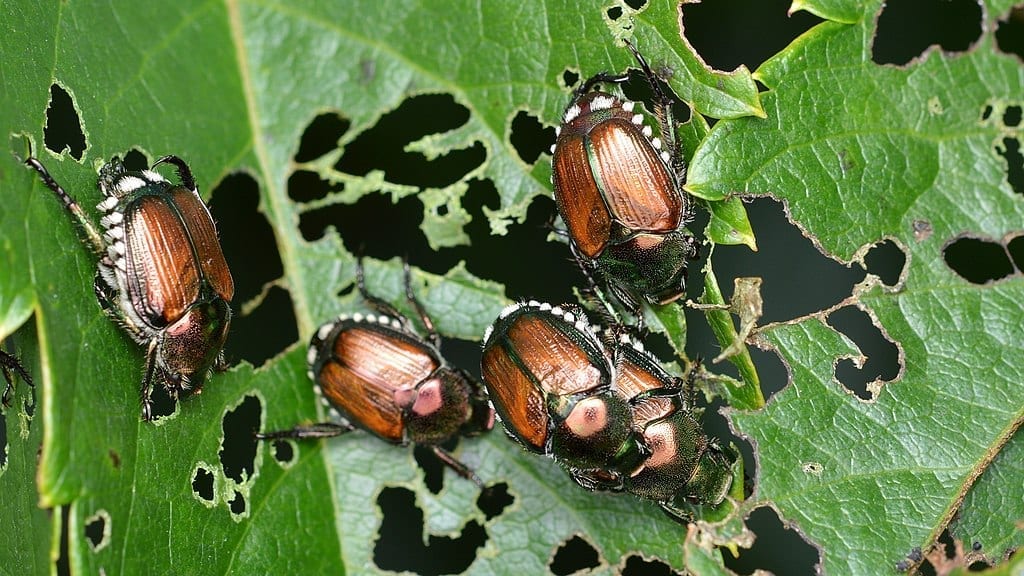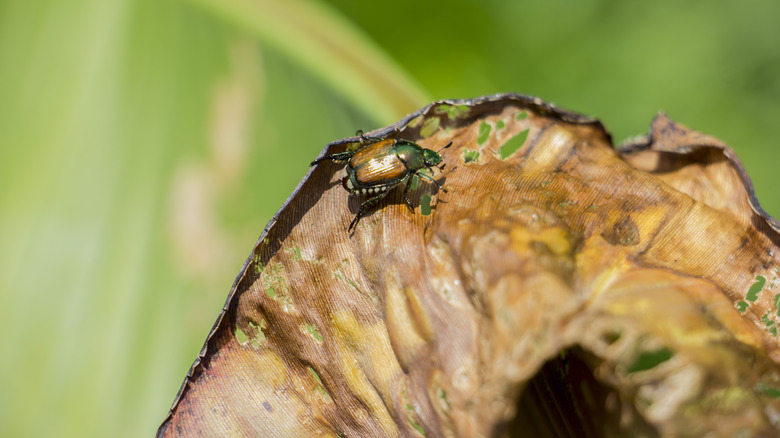You might think Japanese beetles are cool-looking if they weren’t so bad for your hydrangeas and other plants nearby. These bugs are one of the main reasons you might not want to plant hydrangeas in your garden right now. The metallic green and brown beetle can tear your flowers apart bite by bite, so you should run for poison as soon as you see one. Also, beetle outbreaks can look impossible to get rid of because the larvae hide in the soil, and you may not even know it.
Before you pick up a heavy-duty pesticide, try squishing a few beetles and leaving their carcasses to rot. The stench might make you stay away, and thats exactly what will happen to the other beetles. It turns out these insects dont like the sight or smell of their fallen comrades. They hate it so much that it can effectively repel other beetles from landing on your beloved hydrangeas. But you need to let a few of them stay so you can kill them. After that, there shouldn’t be as many in the area.
Do Japanese Beetles Like Hydrangeas? How to Protect Your Plants
Japanese beetles are a common garden pest that can wreak havoc on many plants including hydrangeas. These metallic green beetles have an affinity for the leaves and flowers of hundreds of plant species, which is why it’s important to understand their behavior and have a game plan to thwart them. I’ll explain why Japanese beetles are attracted to hydrangeas the type of damage they cause, and effective organic and chemical control methods.
Japanese Beetles Love Hydrangeas
Unfortunately, hydrangeas are one of the plants that Japanese beetles seem to love to devour. Both the adults and larvae of these pests are likely to feed on your hydrangea bushes if given the chance.
The adult beetles emerge from the soil in summer and flock to the lush green foliage and colorful blooms of hydrangeas. They chew holes in the leaves and petals, marring the plant’s appearance and stunting its growth. The larvae live underground and munch on plant roots from fall through spring. This weakens the plant and makes it more susceptible to other issues.
If you check under the leaves of your hydrangea bushes, you may find the adult beetles clinging tightly in groups of 2 to 5. They try to go undetected, so diligent scouting is required to spot an infestation early before major damage is done.
Telltale Signs of Japanese Beetle Damage
How do you know if Japanese beetles are feasting on your hydrangeas? Look for these signs:
-
Holes in leaves with only the veins remaining. This is called skeletonization.
-
Flowers with large chunks bitten out of the petals.
-
Presence of small green beetles on the undersides of leaves. They quickly drop and play dead if disturbed.
-
Dying, browning patches in lawns indicate larvae feeding on grass roots.
-
Wilting, yellowing plants that don’t perk up with watering. Root damage from larvae can cause this.
The extent of damage depends on the severity of infestation. A few beetles will nibble here and there, while an uncontrolled population will decimate the foliage and flowers. Don’t let them get out of hand!
Organic Ways to Control Japanese Beetles on Hydrangeas
Japanese beetles can be challenging to deter, but here are some effective organic control strategies:
-
Hand pick adults and drop them in soapy water to kill them. Do this early and often before their numbers explode.
-
Use neem oil spray on leaves to repel and kill the beetles. Repeat applications after rain.
-
Encourage beneficial nematodes in the soil to parasitize larvae. Apply them in fall according to package directions.
-
Spread milky spore powder on soil around bushes to infect and kill larvae. Provides long-term control.
-
Cover bushes with floating row cover to create a physical barrier against the beetles.
-
Plant trap crops like geraniums and roses nearby to lure beetles away from hydrangeas.
The key is taking a multifaceted approach focusing on both the adult and larval stage. Combining several methods provides the best protection for your hydrangeas.
Chemical Options for Beetle Control
If organic options aren’t giving you the results you want, insecticide sprays can quickly knock down Japanese beetles on contact:
-
Carbaryl is a commonly used chemical that kills beetles on contact. Apply it to foliage following label directions.
-
Imidacloprid applied to soil is taken up by plant roots and makes leaves and flowers toxic to beetles. Use as directed.
-
Spinosad spray or bait traps lure beetles in and poisons them when ingested. Low toxicity to bees.
-
Pyrethrin sprays made from chrysanthemum flowers provide quick knockdown of beetles. Often mixed with piperonyl butoxide.
While chemical insecticides provide rapid results, they can harm bees and other beneficial insects. Use them only as a last resort if you must. Focus on prevention first with barrier methods and encouraging natural predators like birds, bats, and beneficial insects. A holistic approach leads to the healthiest garden ecosystem.
Cultural Practices to Deter Beetles
Certain gardening practices can make your yard less hospitable to Japanese beetles:
-
Maintain healthy soil with lots of organic matter to encourage beneficial microbes. They help protect roots.
-
Avoid over-fertilizing, especially with quick-release nitrogen. It causes excessive succulent growth that attracts beetles.
-
Pick off egg masses from plant stems and leaves. They look like small brown blobs.
-
Spread diatomaceous earth around bases of plants to discourage larvae from burrowing nearby.
-
Plant beetle-resistant trees like dogwood, magnolia, red maple and holly that they are less attracted to.
By making your yard’s environment less inviting to Japanese beetles, you can avoid major infestations. This prevents the need for intensive control efforts.

Don’t discard every dead beetle

When you spot a Japanese beetle crawling around on your hydrangeas, kill it, but dont discard it. You can squish, step on, whack, or drop it into a cup of soapy water until it dies. Then, place its body around your hydrangeas to warn other beetles that danger is near. You can either leave the beetles where you killed them or put them in a container and hide them next to your plant.
One beetle may not be enough, but that doesnt mean you have to put together an entire graveyard. People don’t like the smell of Japanese beetles either, so there’s no reason to put yourself near your pretty flowers. One way to hide the smell is to mix the dead beetles with carbon-rich compost and then spread it around your hydrangeas. Carbon (leaves, paper, wood) helps hide the smell that comes from the beetle bodies releasing ammonia.
How to get rid of Japanese Beetles ORGANICALLY and save your garden, fruit trees and rose bushes
FAQ
Are hydrangeas resistant to Japanese beetles?
Do hydrangeas attract beetles?
What flower do Japanese beetles hate?
What are three plants the Japanese beetle will most likely infest?
Do beetles eat hydrangeas?
Beetles They sure do like to eat hydrangeas, especially Japanese beetles. There are so many different species of beetles that will feed on hydrangeas that we will group them all into this one section. The damage and treatment of beetles on these plants are very similar.
Do Japanese beetles eat Japanese plants?
Adult Japanese beetles favor these plants and are more susceptible to destruction. Avoid planting them in areas that get regular infestations. Adult Japanese beetles least favor these plants and are less susceptible to destruction. (However, there is no guarantee that these plants won’t be attacked if there are limited food sources in the area!)
Are Japanese beetles coming to your garden?
Photo: Benny Mazur, Flickr Japanese beetle season is upon us or almost upon us, depending on where you live. Not that Japanese beetles (Popilia japonica) are found everywhere, but they are spreading throughout both Europe and North America and chances are that, if your garden isn’t presently under attack, it will be one day soon.
What does beetle damage look like on hydrangeas?
Beetle damage to hydrangeas often looks like something took all the green from the leaf and left behind the veins. Basically, it looks like a leaf skeleton. You’ll probably see the beetles crawling or flying around the plant. One way to treat beetles on your hydrangeas is to pick them off by hand.
Are Japanese beetles dangerous?
Japanese beetles are small insects, but their threat to your garden should not be underestimated. If you allow these insects to remain in your yard unchecked, they will munch on your plants and cause extensive harm.
What is the difference between Japanese beetles and June Bugs?
Japanese beetles are mostly herbivorous, feeding on leaves and fruits of various plants, while June bugs are omnivores that feed on both plant material and small insects. June bugs feed on the roots of grasses and other plants, and can cause damage to lawns and crops. Another noticeable difference between the two insects is their life cycle.
- The Ultimate Guide to Growing Strawberries in Raised Beds - August 8, 2025
- No-Dig Garden Beds: The Easiest Way to Grow a Beautiful Garden - August 6, 2025
- How to Protect and Preserve Wood for Raised Garden Beds - August 6, 2025
